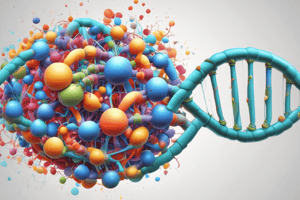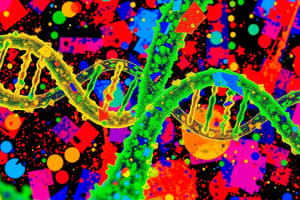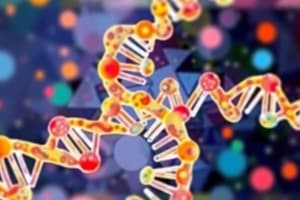Podcast
Questions and Answers
Quel est le rôle principal de la réplication de l'ADN dans la biologie moléculaire ?
Quel est le rôle principal de la réplication de l'ADN dans la biologie moléculaire ?
- Permettre la division cellulaire (correct)
- Transcrire l'information génétique
- Synthétiser de nouvelles protéines
- Réparer les dommages à l'ADN
Quelle est la principale caractéristique de la structure de l'ADN qui suggère un mécanisme de réplication ?
Quelle est la principale caractéristique de la structure de l'ADN qui suggère un mécanisme de réplication ?
- Les appariements de bases complémentaires (correct)
- La structure en double hélice
- La présence de gènes codant pour des enzymes de réplication
- La présence de sucres et de phosphates sur les côtés
Quel est le mécanisme de réplication de l'ADN dans les cellules procaryotes ?
Quel est le mécanisme de réplication de l'ADN dans les cellules procaryotes ?
- Un mécanisme semi-conservatif (correct)
- Un mécanisme dispersif
- Un mécanisme réplicatif
- Un mécanisme conservatif
Quelle étape initie le processus de réplication de l'ADN dans les cellules procaryotes ?
Quelle étape initie le processus de réplication de l'ADN dans les cellules procaryotes ?
Quelle est la principale différence entre la réplication de l'ADN chez les procaryotes et les eucaryotes ?
Quelle est la principale différence entre la réplication de l'ADN chez les procaryotes et les eucaryotes ?
Quel est le principal défi de la réplication de l'ADN dans les cellules eucaryotes ?
Quel est le principal défi de la réplication de l'ADN dans les cellules eucaryotes ?
Quel est le rôle de la primase de brin avancé dans la réplication procaryote ?
Quel est le rôle de la primase de brin avancé dans la réplication procaryote ?
Quelle enzyme est responsable de la formation des fragments d'Okazaki dans la réplication procaryote ?
Quelle enzyme est responsable de la formation des fragments d'Okazaki dans la réplication procaryote ?
Quel est le rôle de la topoisomérase (également connue sous le nom de gyrase) dans la réplication de l'ADN procaryote ?
Quel est le rôle de la topoisomérase (également connue sous le nom de gyrase) dans la réplication de l'ADN procaryote ?
Quelle est la fonction de la protéine de liaison à l'ADN monocaténaire dans la réplication procaryote ?
Quelle est la fonction de la protéine de liaison à l'ADN monocaténaire dans la réplication procaryote ?
Study Notes
DNA Replication in Molecular Biology
DNA replication is the process by which DNA is duplicated in preparation for cell division. In the context of molecular biology, DNA replication refers to the synthesis of a complete copy of a DNA molecule. It is a critical aspect of cell functioning and occurs in both prokaryotic and eukaryotic cells.
Features of DNA Structure Suggesting a Mechanism for DNA Replication
The structure of DNA itself suggests a mechanism for replication. DNA is a double-stranded molecule, much like a twisted ladder, where each rung consists of two complementary nucleotides. The sides of the ladder are formed by sugars and phosphates, with the sugar-phosphate backbone on the outside of the DNA molecule. The rungs are formed by base pairings: Adenine (A) pairs with Thymine (T), while Guanine (G) pairs with Cytosine (C). This complementary structure is crucial for replication because it allows each strand to serve as a template for the synthesis of another strand during replication.
Replication Mechanisms in Prokaryotes and Eukaryotes
Prokaryotic System
In prokaryotic cells, which include bacteria, DNA replication occurs through a semi-conservative mechanism. This means that each new strand of DNA is formed from one old strand and one newly synthesized strand. The process begins with the unwinding of the double helix, followed by the separation of the two strands, which are then acted upon by enzymes for replication.
Eukaryotic System
In eukaryotic cells, DNA replication is a more complex process due to the presence of chromatin, which consists of nucleosomes and other proteins that compact and organize the DNA within the nucleus. The process involves unwinding the chromatin fibers, separating the double helix into two strands, and synthesizing new complementary strands guided by each original strand as a template.
Key Players in Prokaryotic Replication
Some key players in prokaryotic DNA replication include Hershey-Chase leading strand DNA primase, 3' DNA polymerase (Polymerase III), Okazaki fragment formation, topoisomerase (also known as gyrase), and Franklin-Wilkins single-stranded binding protein. These enzymes facilitate the various stages of replication, such as primer formation, elongation, and proofreading.
Conclusion
DNA replication is an essential aspect of molecular biology, involving the duplication of genetic material in preparation for cell division. It occurs through both semi-conservative mechanisms in prokaryotes and more complex processes in eukaryotes, with different enzymes playing crucial roles in these pathways. Understanding DNA replication helps researchers better comprehend fundamental biological processes and explore potential applications in fields such as gene therapy and synthetic biology.
Studying That Suits You
Use AI to generate personalized quizzes and flashcards to suit your learning preferences.
Description
Explore the process of DNA replication in molecular biology, where DNA is duplicated in preparation for cell division. Learn about the structure of DNA, replication mechanisms in prokaryotic and eukaryotic cells, and the key players involved in the replication process.




